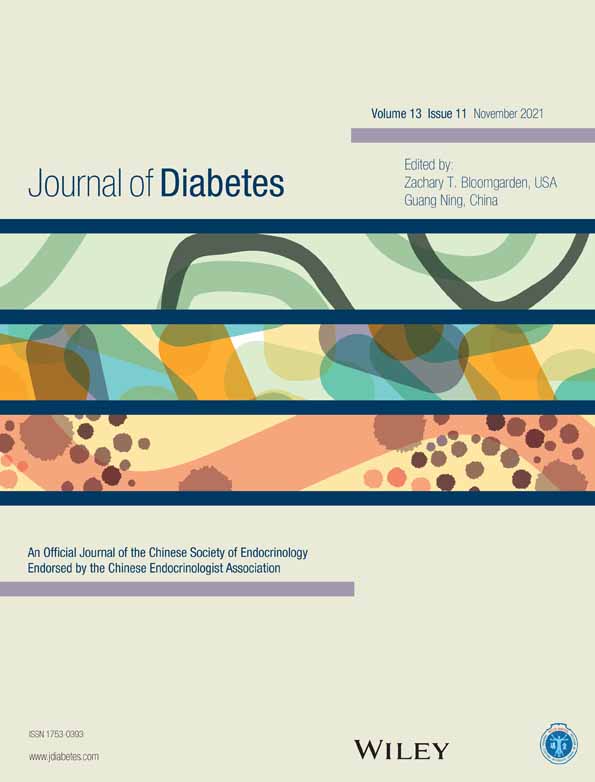Urinary C-peptide/creatinine ratio: A useful biomarker of insulin resistance and refined classification of type 2 diabetes mellitus
尿C肽/肌酐比值:一个评估胰岛素抵抗水平并改善2型糖尿病精准分型的有效生物标志物
Linong Ji and Xueyao Han equally contributed to this study.
Funding information: National Key Research and Development Program, Grant/Award Number: 2016YFC1304901; The Beijing Municipal Commission of Science and Technology funds, Grant/Award Numbers: Z141100007414002, D131100005313008
Abstract
enBackground
The urinary C-peptide/creatinine ratio (UCPCR) is low in patients with type 1 diabetes mellitus, but it has not been well characterized in patients with type 2 diabetes mellitus (T2DM). We aimed to measure the UCPCRs in patients with T2DM and explore the relationships among UCPCR, insulin resistance (IR), and chronic vascular complications of diabetes.
Methods
A cross-sectional study was performed of 1299 Chinese hospitalized patients with T2DM. Binary logistic regression was used to evaluate the relationships between the chronic vascular complications of diabetes and UCPCR. K-means analysis was used to allocate participants to subgroups with five to six variables (age at diagnosis, body mass index [BMI], glycosylated hemoglobin, homoeostasis model assessment 2-estimated beta-cell function (HOMA2-B), and HOMA2-insulin resistance (HOMA2-IR), with or without UCPCR).
Results
UCPCR positively correlated with HOMA2-IR (r = 0.448, P < .001). After adjustment for sex, age, duration of diabetes, and other cardiovascular risk factors, UCPCR was positively associated with diabetic kidney disease (DKD) (odds ratio [OR] = 1.198, 95% CI 1.019-1.408, P = .029) and coronary heart disease (CHD) (OR = 1.312, 95% CI 1.079-1.594, P = .006). When UCPCR was added, cluster analysis using the six variables identified five subgroups of T2DM, characterized by differing age at diagnosis, BMI, beta-cell function, IR, and prevalence of vascular complications.
Conclusions
UCPCR is positively associated with IR, DKD, and CHD and represents a promising biomarker that could refine the classification of T2DM.
摘要
zh背景
1型糖尿病患者尿C肽/肌酐比值水平低。但尿C肽/肌酐比值在2型糖尿病患者中并没有被充分评估, 本研究拟测定2型糖尿病患者的尿C肽/肌酐比值水平, 探讨尿C肽/肌酐比值与胰岛素抵抗及糖尿病慢性血管并发症的相关性, 并评估尿C肽/肌酐比值改善2型糖尿病精准分型的可能性。
方法
本研究共纳入北京大学人民医院内分泌科住院2型糖尿病患者1299名。采集所有患者的临床资料, 测定其空腹尿C肽/肌酐比, 通过二元Logistic回归分析尿C肽/肌酐比值与糖尿病血管并发症的相关性。并分别用传统的五个变量[诊断年龄, 体重指数, 糖化血红蛋白, 改良稳态模型计算的β细胞功能指数(HOMA2-B)及胰岛素抵抗指数(HOMR2-IR)]和加入尿C肽/肌酐比值后的六个变量, 通过相同的k-means聚类算法对2型糖尿病患者进行聚类分组, 比较不同亚组的临床特点。
结果
尿C肽/肌酐比值与HOMA2-IR水平 (r=0.448, P<0.001)正相关。在调整了性别, 年龄, 病程及其他心血管疾病危险因素后, 尿C肽/肌酐比值水平与糖尿病肾病 [比值比(OR) =1.198, 95%CI (1.019, 1.408), P=0.029]及冠状动脉粥样硬化性心脏病的发生风险呈正相关 [OR=1.312, 95%CI (1.079, 1.594), P=0.006]。在五个传统临床变量基础上, 加入尿C肽/肌酐比值后再进行聚类分型, 可以清晰地将患者分为五组:两组具有早发糖尿病特征[早发胰岛素缺乏型糖尿病(n=350)和早发胰岛素抵抗型糖尿病(n=176)], 两组具有晚发糖尿病特征[晚发胰岛素缺乏型糖尿病(n=318)和晚发胰岛素抵抗型糖尿病(n=133)]及轻型糖尿病(n=299)。各组间诊断年龄, 体重指数, 胰岛β细胞功能, 胰岛素抵抗水平以及糖尿病血管并发症比例显著不同。
结论
尿C肽/肌酐比值与胰岛素抵抗水平及糖尿病肾病, 冠状动脉粥样硬化性心脏病发生风险正相关。在传统临床变量基础上引入尿C肽/肌酐比值, 可以改善2型糖尿病的精准分型。
CONFLICT OF INTEREST
All authors declare that they have no conflict of interest.




